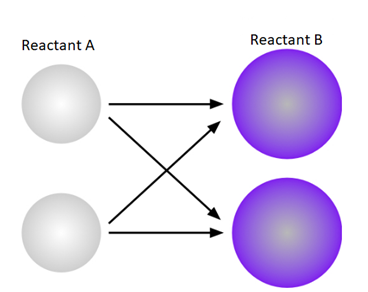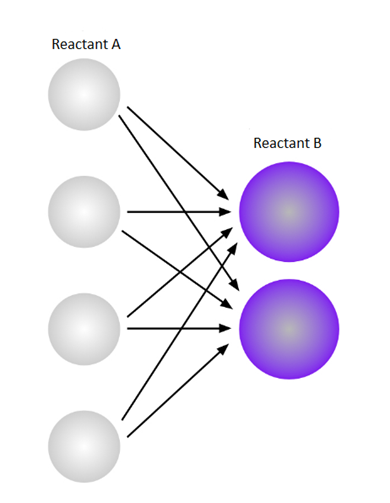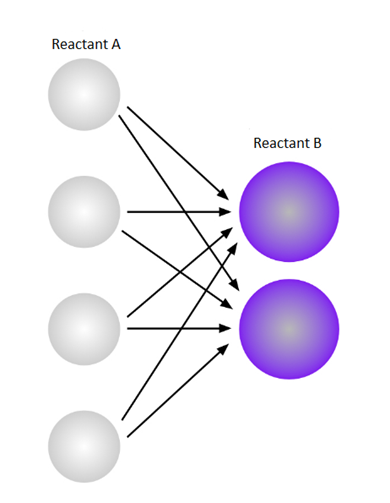
Interpretation:
A diagram needs to be constructed that shows all of the possible collision combinations between two molecules of Reactant A and two molecules of Reactant B. Also, each possible A-B collision combination needs to be sketched on increasing the number of molecules A from two to four. The factor increasing the number of collision combinations needs to be explained.
Concept introduction:
Molecules undergo collision in the presence of the required amount of energy needed for collision to form some new molecules as well as in the presence of correct molecular orientation.
Answer to Problem 87A

The above diagram shows the possible collision between two molecules A and B. There is a possibility of four collisions in this case.

The above diagram shows possible collision when the number of reactant A is double. The possible collision in this case is 8.
The reaction rate doubles when the reactant molecule taken is doubled.
Explanation of Solution
A diagram that shows all of the possible collision combinations between two molecules of Reactant A and two molecules of Reactant B is given below.

There four different possible combinations are possible on collision of two molecules of reactant A and two molecules of reactant B.
Now, a diagram where each possible A-B collision combination on increasing the number of molecules A from two to four is shown below,

On increasing the number of moleculeA from two to four, there exist 8 possible combinations of the different reactants during a collision. By this we can say that on doubling the concentration of one reactant, the number of possible collisions also doubles. The doubling in the collision, the reaction rate also tends to double.
The reaction rate doubles when the reactant molecule taken is doubled.
Chapter 16 Solutions
Chemistry: Matter and Change
Additional Science Textbook Solutions
General, Organic, and Biological Chemistry (3rd Edition)
Introductory Chemistry (5th Edition) (Standalone Book)
Organic Chemistry (9th Edition)
Chemistry: Structure and Properties
Introductory Chemistry (6th Edition)
Chemistry: A Molecular Approach (4th Edition)
 ChemistryChemistryISBN:9781305957404Author:Steven S. Zumdahl, Susan A. Zumdahl, Donald J. DeCostePublisher:Cengage Learning
ChemistryChemistryISBN:9781305957404Author:Steven S. Zumdahl, Susan A. Zumdahl, Donald J. DeCostePublisher:Cengage Learning ChemistryChemistryISBN:9781259911156Author:Raymond Chang Dr., Jason Overby ProfessorPublisher:McGraw-Hill Education
ChemistryChemistryISBN:9781259911156Author:Raymond Chang Dr., Jason Overby ProfessorPublisher:McGraw-Hill Education Principles of Instrumental AnalysisChemistryISBN:9781305577213Author:Douglas A. Skoog, F. James Holler, Stanley R. CrouchPublisher:Cengage Learning
Principles of Instrumental AnalysisChemistryISBN:9781305577213Author:Douglas A. Skoog, F. James Holler, Stanley R. CrouchPublisher:Cengage Learning Organic ChemistryChemistryISBN:9780078021558Author:Janice Gorzynski Smith Dr.Publisher:McGraw-Hill Education
Organic ChemistryChemistryISBN:9780078021558Author:Janice Gorzynski Smith Dr.Publisher:McGraw-Hill Education Chemistry: Principles and ReactionsChemistryISBN:9781305079373Author:William L. Masterton, Cecile N. HurleyPublisher:Cengage Learning
Chemistry: Principles and ReactionsChemistryISBN:9781305079373Author:William L. Masterton, Cecile N. HurleyPublisher:Cengage Learning Elementary Principles of Chemical Processes, Bind...ChemistryISBN:9781118431221Author:Richard M. Felder, Ronald W. Rousseau, Lisa G. BullardPublisher:WILEY
Elementary Principles of Chemical Processes, Bind...ChemistryISBN:9781118431221Author:Richard M. Felder, Ronald W. Rousseau, Lisa G. BullardPublisher:WILEY





